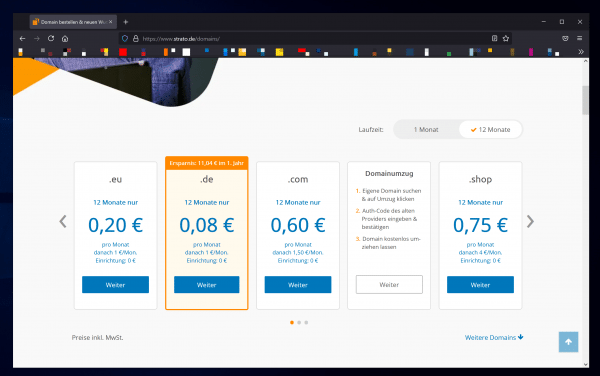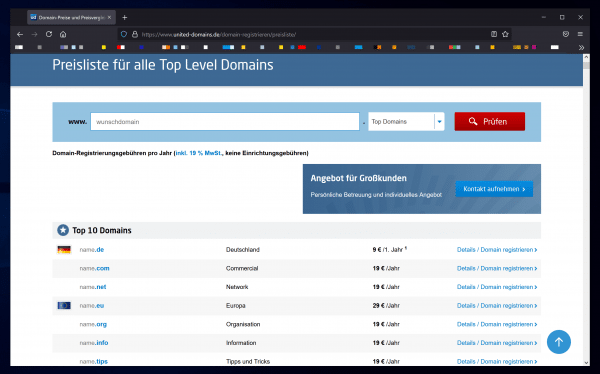If you want to set up your own internet presence, there is no getting around your own domain. In this article you will find out what options you have when registering a domain and what you should pay attention to.
Domain - what is it anyway?
A domain is a unique address on the Internet at which an Internet presence can be called up by entering the domain name in the address line of the browser. The domain ending, known as the so-called top-level domain (TLD), comes after the domain name and is separated from it by a period. TLDs usually contain the abbreviations for the respective country in which the servers of the website are located. The TLD .de is common in Germany. Commercial companies often use the .com TLD for their websites. Educational institutions have often registered their domains under the TLD .edu. In the USA the TLD .gov is used by government bodies. You can find more general information about domains here.
Register your own domain - this is how it works
Domain registration is possible for everyone in Germany and many other countries. It is important to know that a domain name, also known as a second-level domain , can only be assigned once. You should therefore think carefully about the Internet address at which you would like to be reached. The rule here is that the person who registered your domain name first is usually assigned it first. Here, too, there are exceptions where other claims may arise if they arise from various legal situations. To register a domain, basically proceed in the same way as for normal online shopping:
You visit the domain provider of your choice and check whether the domain of your choice is free. The search result shows whether the domain is already taken or whether you can still secure it. You can still buy some domains that are already registered, provided that the owner offers them for sale. If the desired domain is free, simply put it in the shopping cart. In the ordering process you have to create your personal data (last name, first name, address, telephone, email address and payment information) for a customer account. Without this data, your own domain cannot be registered. The domain provider transmits your desired domain together with your owner data to the registry and instructs the registry with the registration. The registry then notifies the provider,that the domain was successfully registered. The domain provider will notify you by email that the domain has been registered in your name. Depending on the domain provider and registry, only a few minutes to several hours can pass between the registration application and the registration confirmation..
Register your own domain - you still have to pay attention to this
The domain name can be chosen freely. In principle, all letters of the alphabet as well as the digits 0-9 and the single dash can be used for the domain name. Ideally, a domain is easy to remember, concise and as short as possible. Once you have found the perfect domain name, you should check in the next step whether it is still available, i.e. not being used by any other user. You can quickly and easily check your desired domain on the domain provider "Checkdomain" . After a successful domain check, you can register your domain and even create your website via the provider. If you decide on hosting, you can choose between various service packages. Read more about hosting here.
Domain providers in comparison
If you decide on a domain, you have to secure it through a provider. The offer is large, the offers hardly differ, mostly only in the details. Domain providers often offer several services in addition to the pure domain allocation. You can purchase entire hosting packages or have websites created. We have compared 3 major domain providers for you and show you what they can offer you..
Ionos by 1 & 1
With the domain provider Ionos you can enter your desired domain quickly and easily and save it immediately if the domain name is free. Depending on the desired TLD, you pay between 8 and 70 cents per month for a domain. However, this price is only valid for the first year, after which the monthly costs increase significantly. For example, if you pay only 8 cents per month for a .de domain in the first year, the costs increase to a full 1.30 € per month in the second year. There is no registration fee.
 The offer page for domains of the domain provider ionos.de is very clearly laid out.
The offer page for domains of the domain provider ionos.de is very clearly laid out. Strato
The domain provider Strato offers a similar range of services as the provider Ionos, although the costs from the second year onwards differ considerably. Here you also have to pay 8 cents per month for a .de domain in the first year, but from the second year you only pay 1 euro per month. The 2 GB e-mail inbox is included, as is the case with the Ionos provider. If additional features are required, such as more mailboxes or an additional domain, additional packages can be purchased. At Strato.de there is an additional registration fee of 15 € for a domain registration.
 The same applies to the supply page for domains of the domain provider strato.de.
The same applies to the supply page for domains of the domain provider strato.de. United Domains In comparison, the
domain provider United Domains is a rather small German company in the field of domain allocation. The provider has a smaller range and also higher prices. You pay € 9 for a .de domain in the first year and € 19 from the second. There are no registration fees for setting up a domain. In addition, the German company advertises that it uses 100% green electricity.
 United Domains clearly lists all available TLDs, including prices.
United Domains clearly lists all available TLDs, including prices.